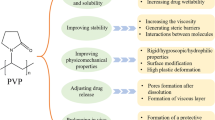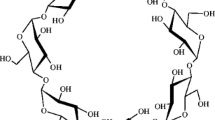Abstract
The aim of this study was to prepare inclusion complexes of hinokitiol (HT)/α-cyclodextrin (α-CD) and HT/β-cyclodextrin (β-CD) by cogrinding and to evaluate the differences in their formation. The physical properties of the preparation were evaluated by Job’s plot, phase solubility studies, differential scanning calorimetry, powder X-ray diffraction, solid fluorescence spectra, and infrared absorption spectra. Intermolecular interaction in the solid state was confirmed to be in the ratios HT/α-CD = 1/2 and HT/β-CD = 1/1. Results indicated that the dissolution property of HT was improved by inclusion in the complexes HT/α-CD and HT/β-CD compared with HT crystals. The 1H-1H ROESY NMR spectrum of HT/α-CD showed that part of the seven-membered ring of HT and the isopropyl group of HT was linked to the wider edges of the two α-CDs. In HT/β-CD, the seven-membered ring of HT interacted with the narrower edge of β-CD and the isopropyl group of HT interacted with the wider edges. This structure of inclusion complexes was attributed to the difference in the cavity diameter of the CD and was thought to influence the dissolution properties.











Similar content being viewed by others
References
Oblak EZ, Bolstad ES, Ononye SN, Priestley ND, Hadden MK, Wright DL. The furan route to tropolones: probing the antiproliferative effects of β-thujaplicin analogs. Org Biomol Chem. 2012;10:8597–604.
Komaki N, Watanabe T, Ogasawara A, Sato N, Mikami T, Matsumoto T. Antifungal mechanism of hinokitiol against Candida albicans. Biol Pharm Bull. 2008;31:735–7.
Yen TB, Chang HT, Hsieh CC, Chang ST. Antifungal properties of ethanolic extract and its active compounds from Calocedrus macrolepis var. formosana (Florin) heartwood. Bioresour Technol. 2008;99:4871–7.
Miyamoto D, Kusagaya Y, Endo N, Sometani A, Takeo S, Suzuki T, Arima Y, Nakajima K, Suzuki Y. Thujaplicin-copper chelates inhibit replication of human influenza viruses. Antivir Res. 1998;39(2):89–100.
Koufaki M, Theodorou E, Alexi X, Nikoloudaki F, Alexis MN. Synthesis of tropolone derivatives and evaluation of their in vitro neuroprotective activity. Eur J Med Chem. 2010;45:1107–12.
Choi YG, Bae EJ, Kim DS, Park SH, Kwon SB, Na JI, Park KC. Differential regulation of melanosomal proteins after hinokitiol treatment. J Dermatol Sci. 2006;43:181–8.
Shih MF, Chen LY, Tsai PJ, Cherng JY. In vitro and in vivo therapeutics of β-thujaplicin on LPS-induced inflammation in macrophages and septic shock in mice. Int J Immunopathol Pharmacol. 2012;25:39–48.
Liu S, Yamauchi H. p27-Associated G1 arrest induced by hinokitiol in human malignant melanoma cells is mediated via down-regulation of pRb, Skp2 ubiquitin ligase, and impairment of Cdk2 function. Cancer Lett. 2009;286:240–9.
Brewster ME, Loftsson T. Cyclodextrins as pharmaceutical solubilizers. Adv Drug Deliv Rev. 2007;59:645–66.
Ogawa N, Higashi K, Nagase H, Endo T, Moribe K, Loftsson T, Yamamoto K, Ueda H. Effects of cogrinding with β-cyclodextrin on the solid state fentanyl. J Pharm Sci. 2010;99:5019–29.
Zhang JQ, Wu D, Jiang KM, Zhang D, Zheng X, Wan CP, Zhu HY, Xie XG, Jin Y, Lin J. Preparation, spectroscopy and molecular modelling studies of the inclusion complex of cordycepin with cyclodextrins. Carbohydr Res. 2015a;406:55–64.
Zhang JQ, Jiang KM, An K, Ren SH, Xie XG, Jin Y, Lin J. Novel water-soluble fisetin/cyclodextrins inclusion complexes: preparation, characterization, molecular docking and bioavailability. Carbohydr Res. 2015b;418:20–8.
Suzuki R, Inoue Y, Tsunoda Y, Murata I, Isshiki Y, Kondo S, Kanamoto I. Effect of γ-cyclodextrin derivative complexation on the physicochemical properties and antimicrobial activity of hinokitiol. J Incl Phenom Macrocycl Chem. 2015;83:177–86.
Specogna E, Li KW, Djabourov M, Carn F, Bouchemal K. Dehydration, dissolution, and melting of cyclodextrin crystals. J Phys Chem B. 2015;119:1433–42.
Job P. Formation and stability of inorganic complexes in solution. Annales de Chimie et de Physique. 1928;9:113–203.
Higuchi T, Connors KA. Phase-solubility techniques. In: Reilly CN, editor. Advances in analytical chemistry and instrumentation, vol. 4. New York: Wiley-Interscience; 1965. p. 117–212.
Ge X, Huang Z, Tian S, Huang Y, Zeng C. Complexation of carbendazim with hydroxypropyl-β-cyclodextrin to improve solubility and fungicidal activity. Carbohydr Polym. 2012;89(1):208–12.
Ulatowski F, Dąbrowa K, Bałakier T, Jurczak J. Recognizing the limited applicability of job plots in studying host-guest interactions in supramolecular chemistry. J Org Chem. 2016;81(5):1746–56.
Negi JS, Singh S. Spectroscopic investigation on the inclusion complex formation between amisulpride and γ-cyclodextrin. Carbohydr Polym. 2013;92:1835–43.
Nguyen TA, Liu B, Zhao J, Thomas DS, Hook JM. An investigation into the supramolecular structure, solubility, stability and antioxidant activity of rutin/cyclodextrin inclusion complex. Food Chem. 2013;136:186–92.
Jug M, Kosalec I, Maestrelli F, Mura P. Analysis of triclosan inclusion complexes with β-cyclodextrin and its water-soluble polymeric derivative. J Pharm Biomed Anal. 2011;54:1030–9.
Xiao CF, Li K, Huang R, He GJ, Zhang JQ, Zhu L, Yang QY, Jiang KM, Jin Y, Lin J. Investigation of inclusion complex of epothilone A with cyclodextrins. Carbohydr Polym. 2014;102:297–305.
Giordano F, Novak C, Moyano JR. Thermal analysis of cyclodextrins and their inclusion compounds. Thermochim Acta. 2001;380:123–51.
Nakai Y, Yamamoto K, Terada K, Kajiyama A, Sasaki I. Properties of crystal water of a-, β-, and γ-cyclodextrin. Chem Pharm Bull. 1986;34:2178–82.
Inoue Y, Iohara D, Sekiya N, Yamamoto M, Ishida H, Sakiyama Y, Hirayama F, Arima H, Uekama K. Ternary inclusion complex formation and stabilization of limaprost, a prostaglandin E1 derivative, in the presence of α- and β-cyclodextrins in the solid state. Int J Pharm. 2016;509:338–47.
Aigner Z, Berkesi O, Farkas G, Szabó-Révész P. DSC, X-ray and FTIR studies of a gemfibrozil/dimethyl-β-cyclodextrin inclusion complex produced by co-grinding. J Pharm Biomed Anal. 2012;57:62–7.
Iwata M, Fukami T, Kawashima D, Sakai M, Furuishi T, Suzuki T, Tomono K, Ueda H. Effectiveness of mechanochemical treatment with cyclodextrins on increasing solubility of glimepiride. Pharmazie. 2009;64(6):390–4.
Hunt MA, Rusa CC, Tonelli AE, Balik CM. Structure and stability of columnar cyclomaltohexaose (alpha-cyclodextrin) hydrate. Carbohydr Res. 2004;339(17):2805–10.
Karoyo AH, Sidhu P, Wilson LD, Hazendonk P. Characterization and dynamic properties for the solid inclusion complexes of β-cyclodextrin and perfluorooctanoic acid. J Phys Chem B. 2013;117(27):8269–82.
Breheret EF, Martin MM. Electronic relaxation of troponoids: tropolone fluorescence. J Lumin. 1978;17:49–60.
MacKenziea VJ, Sinhaa HK, Wallaceb SC, Steera RP. Photophysics of tropolone. Chem Phys Lett. 1999;305:1–7.
Fernandes CM, Teresa Vieira M, Veiga FJ. Physicochemical characterization and in vitro dissolution behavior of nicardipine-cyclodextrins inclusion compounds. Eur J Pharm Sci. 2002;15:79–88.
Takayanagi M, Ito S, Matsumoto K, Nagaoka M. Formation of reactant complex structure for initiation reaction of lactone ring-opening polymerization by cooperation of multiple cyclodextrin. J Phys Chem B. 2016;120(29):7174–81.
Mohamad S, Surikumaran H, Raoov M, Marimuthu T, Chandrasekaram K, Subramaniam P. Conventional study on novel dicationic ionic liquid inclusion with β-cyclodextrin. Int J Mol Sci. 2011;12:6329–45.
Tárkányi G, Németh K, Mizsei R, Tőke O, Visy J, Simonyi M, Jicsinszky L, Szemán J, Szente L. Structure and stability of warfarin-sodium inclusion complexes formed with permethylated monoamino-β-cyclodextrin. J Pharm Biomed Anal. 2013;72:292–8.
Rudrangi SR, Bhomia R, Trivedi V, Vine GJ, Mitchell JC, Alexander BD, Wicks SR. Influence of the preparation method on the physicochemical properties of indomethacin and methyl-β-cyclodextrin complexes. Int J Pharm. 2015;479(2):381–90.
Graeser KA, Patterson JE. The role of configurational entropy in amorphous systems. Pharmaceutics. 2010;2(2):224–44.
Zhou Q, Wei X, Dou W, Chou G, Wang Z. Preparation and characterization of inclusion complexes formed between baicalein and cyclodextrins. Carbohydr Polym. 2013;95(2):733–9.
Lis-Cieplak A, Sitkowski J, Kolodziejski W. Comparative proton nuclear magnetic resonance studies of amantadine complexes formed in aqueous solutions with three major cyclodextrins. J Pharm Sci. 2014;103:274–82.
Miletic T, Kyriakos K, Graovac A, Ibric S. Spray-dried voriconazole-cyclodextrin complexes: solubility, dissolution rate and chemical stability. Carbohydr Polym. 2013;98:122–31.
Acknowledgements
The authors are grateful to Cyclo Chem Co., Ltd. for the provision of α-CD and β-CD.
Author information
Authors and Affiliations
Corresponding author
Ethics declarations
Conflict of Interests
The authors declare that they have no conflict of interests.
Rights and permissions
About this article
Cite this article
Suzuki, R., Inoue, Y., Limmatvapirat, S. et al. Molecular interactions of the inclusion complexes of hinokitiol and various cyclodextrins. AAPS PharmSciTech 18, 2717–2726 (2017). https://doi.org/10.1208/s12249-017-0748-7
Received:
Accepted:
Published:
Issue Date:
DOI: https://doi.org/10.1208/s12249-017-0748-7




